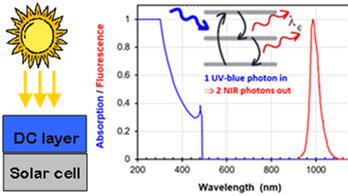The deep ultraviolet radiation that is present in the extra-terrestrial (air-mass zero) solar spectrum: i) is difficult for solar cells to effectively convert into photogenerated current; and ii) is also damaging for either the semiconductor itself and/or other components in the photovoltaic module [1]. A down-conversion (DC) layer has the potential to generate two low-energy (near-infrared) photons for each incident high-energy (ultraviolet-blue) photon, i.e. achieving a 200% quantum yield (QY) [2]. Theory has predicted that a DC layer in conjunction with a silicon solar cell result in a conversion efficiency of up to 38.6% [3]. Until recently, there was a dearth of materials that were able to achieve DC in a wavelength range relevant for photovoltaics. However, recently, an exciting class of DC materials has been developed based on the Yb3+-doped CsPbCl3 metal halide perovskite system that can achieved 980nm emission with a QY approaching 200% [4]. However, attempts to achieve this experimentally on a device – i.e. thus realising a device internal quantum efficiency (IQE) of > 100% – have been foiled by a “photon bottleneck” problem [5], which prevents such high QY values being achieved under the standard solar flux of sunlight. In this proposal, a four-pronged approach is employed to solving this problem. Firstly, novel core-shell nanocrystals will be developed that enable the Yb3+ ion concentration to be optimised. Secondly, the study will be supported by in-depth optical modelling, an example of which is shown in the picture above (right) whereby ray-tracing predicts a ~3 abs. % efficiency enhancement for a silicon solar cell when equipped with a DC layer. Thirdly, optical spectroscopy will be employed to deeply understand the nature of the photon bottleneck. Finally, DC layers will be placed onto silicon solar cells in order to evaluate whether filtering the sub-450nm light increases the UV photostability of the devices.

